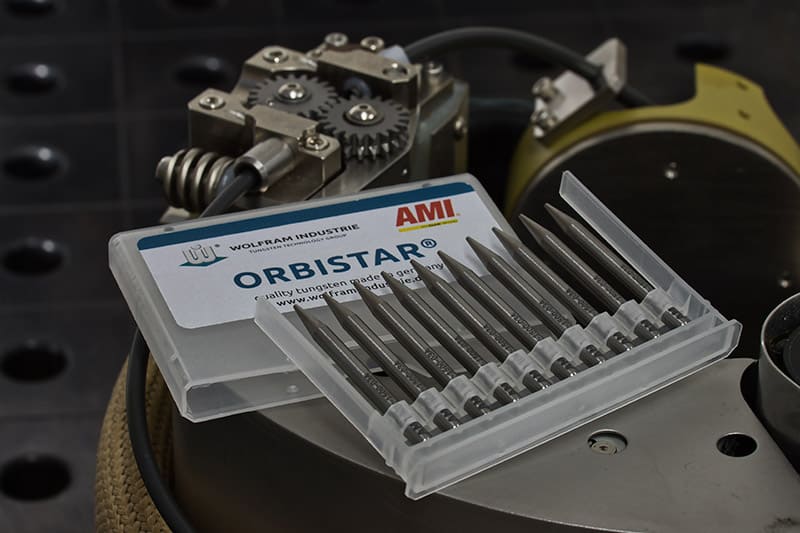
Tungsten is a robust metal with unique properties commonly used for the manufacturing of welding electrodes. It has the highest tensile strength of any metal and can retain it even at a high melting point of all at 3422° C (6192° F). This makes it an excellent choice for Gas Tungsten Arc Welding (GTAW), also known as Tungsten Inert Gas (TIG) welding. For TIG welding applications, non-consumable tungsten electrodes assist in forming clean, precise, and high-quality welds.
However, when selecting tungsten electrodes for the welding process, welders must consider many different variables. For example, the type of tungsten electrode, workpiece material, and electrical current play important roles in the final selection. Let’s examine how these considerations inform welders on how to select a tungsten electrode size that will ensure the highest quality performance and weld.
Types of Tungsten Electrodes used in TIG Welding
GTAW, or TIG, welding uses a tungsten electrode to form an arc with the workpiece using an inert gas, generally argon or helium. A perfectly sized electrode is essential in creating a consistent and precise arc. For this reason, electrode selection should be an important part of the welding equipment setup process. The type of tungsten used and the electrical current, discussed below, are major factors that can influence how to select a tungsten electrode size for any welding application.
Selecting the Tungsten Type for TIG Welding Applications
GTAW or TIG welding uses different types of tungsten electrodes for different applications. These electrodes differ in their chemical composition and are color-coded for easy identification, as listed in the table below.
| TUNGSTEN ELECTRODE TYPES AND CURRENT OPTIONS |
| Type of Tungsten | Color Code | Current Type |
| Pure | Green | AC |
| 1% Thoriated | Yellow | DC |
| 2% Thoriated | Red | DC |
| Ceriated | Grey | AC / DC |
| 1.5% Lanthanated | Gold | AC / DC |
| Zirconiated | White | AC |
TIG welding is widely used in industries like aerospace, pharmaceutical, automotive, nuclear, and manufacturing. High-quality and consistent welding results for applications in these industries require the most appropriate tungsten electrode from the list above. Electric current, which is discussed in the following section, must also be considered.
Role of Electric Current in Choosing Tungsten Electrodes
Some welding processes can use DC as well as AC. The electrical current is responsible for the amount of heat generated on the electrode. To keep balanced heat on the electrode, the tungsten electrode should not be operated at more than the specified current level. Although the tungsten electrode has a high melting point, using a higher than recommended current can cause the tungsten particles to transfer to the weld pool. This can result in a weak or defective weld joint. A lower than recommended current, on the other hand, can create an unstable arc.
Current Level Can Guide How to Select a Tungsten Electrode Size
Different sizes of tungsten electrodes are required for different applications depending upon the material thickness, composition, and power source. It is also always beneficial to follow the manufacturer’s recommendation and Welding Procedure Specification (WPS) sheet when setting up welding equipment and selecting the electrode size. Thinner tungsten electrodes can provide a great arc start but have temperature limitations. Thicker electrodes generally withstand more heat and have a longer service life. The diameter of the tungsten and amperage required is also dependent on the base metal being welded. As an example, the following table lists the electrical current range for stainless steel fusion welding applications.
| TUNGSTEN ELECTRODE SIZE AND CURRENT FOR STAINLESS STEEL WELDING |
| Tungsten electrode diameter | Amperage |
| 1 mm | 10 – 30 amps |
| 1.6 mm | 30 – 80 amps |
| 2.4 mm | 80 – 150 amps |
| 3.2 mm | > 150 amps |
For other materials like Inconel®, titanium, or copper, the diameter and amperage range can be slightly higher.
Tungsten electrodes have chemical, mechanical, and thermal properties that make them a good choice for welding applications where weld strength and high-temperature resistance are premium requirements. However, care must be exercised when choosing the best tungsten electrode size to avoid issues, such as pool contamination due to melting tips. When TIG welding with tungsten electrodes, the best way to ensure consistent, high-quality welds is to employ an orbital welding process and equipment.
Arc Machines, Inc. is a leading name in orbital welding solutions, providing reliable and high-quality GTAW orbital welders and GTAW tungsten electrodes. For inquiries regarding products, contact sales@arcmachines.com. For service inquiries, such as how to select tungsten electrode size, contact service@arcmachines.com. Arc Machines welcomes the opportunity to discuss your specific needs. Contact us to arrange a meeting.




